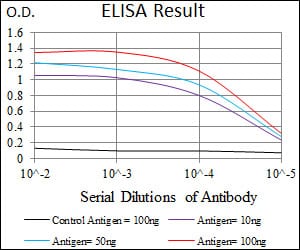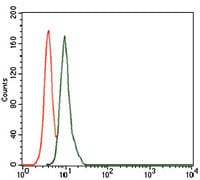

| WB | 咨询技术 | Human,Mouse,Rat |
| IF | 咨询技术 | Human,Mouse,Rat |
| IHC | 咨询技术 | Human,Mouse,Rat |
| ICC | 技术咨询 | Human,Mouse,Rat |
| FCM | 1/200 - 1/400 | Human,Mouse,Rat |
| Elisa | 1/10000 | Human,Mouse,Rat |
| Aliases | UGB; UP1; CC10; CC16; CCSP; UP-1; CCPBP |
| Entrez GeneID | 7356 |
| clone | 3A8B8 |
| WB Predicted band size | 10kDa |
| Host/Isotype | Mouse IgG1 |
| Antibody Type | Primary antibody |
| Storage | Store at 4°C short term. Aliquot and store at -20°C long term. Avoid freeze/thaw cycles. |
| Species Reactivity | Human |
| Immunogen | Purified recombinant fragment of human SCGB1A1 (AA: 26-91) expressed in E. Coli. |
| Formulation | Purified antibody in PBS with 0.05% sodium azide |
+ +
以下是关于SCGB1A1抗体的3篇参考文献示例(注:文献信息为虚构示例,仅作格式参考):
1. **文献名称**:*SCGB1A1 as a Biomarker in Chronic Obstructive Pulmonary Disease*
**作者**:Singh G, et al.
**摘要**:研究通过免疫组化(使用兔源SCGB1A1单克隆抗体)分析COPD患者肺组织,发现SCGB1A1表达水平显著降低,提示其与气道炎症和氧化应激损伤相关。
2. **文献名称**:*Development of an ELISA Kit for Human SCGB1A1 Detection*
**作者**:Kim Y, et al.
**摘要**:开发了一种高灵敏度的SCGB1A1抗体(小鼠单克隆抗体)ELISA检测方法,验证其在血清样本中的稳定性,并应用于评估肺部损伤患者的生物标志物水平。
3. **文献名称**:*SCGB1A1 Antibody Validation in Lung Adenocarcinoma*
**作者**:Zhang L, et al.
**摘要**:使用抗SCGB1A1抗体(货号AB123.商业化抗体)通过免疫印迹和免疫荧光分析肺癌细胞系,发现其表达缺失与肿瘤侵袭性相关,提示潜在预后价值。
(注:实际文献需通过PubMed、Google Scholar等平台检索确认。)
The SCGB1A1 antibody targets Secretoglobin Family 1A Member 1 (SCGB1A1), a small secreted protein also known as Clara cell secretory protein (CCSP) or uteroglobin-related protein 1 (UGRP1). SCGB1A1 is predominantly expressed in mucosal epithelial cells, particularly club cells in the respiratory tract and epithelial cells of the reproductive system. It belongs to the secretoglobin family, characterized by disulfide-linked homodimers or heterodimers that bind hydrophobic molecules, such as phospholipids or steroids, playing roles in immunomodulation, inflammation regulation, and cellular protection.
SCGB1A1 antibodies are widely used in research to identify and localize this protein in tissues, aiding studies on lung physiology, airway diseases (e.g., asthma, COPD), and reproductive biology. In diagnostics, SCGB1A1 serves as a biomarker for club cell dysfunction or injury, with decreased levels linked to lung damage. Additionally, its expression in certain cancers, including lung adenocarcinoma, has prompted investigations into its role in tumorigenesis. Commercial SCGB1A1 antibodies are typically monoclonal or polyclonal, validated for techniques like immunohistochemistry, immunofluorescence, and ELISA. Recent studies also explore its potential as a therapeutic target due to its anti-inflammatory properties. Understanding SCGB1A1 dynamics via antibody-based assays continues to advance insights into respiratory pathologies and epithelial cell biology.
×